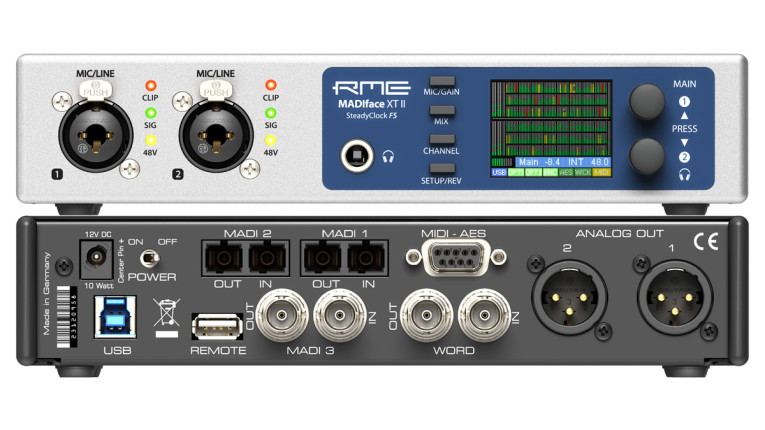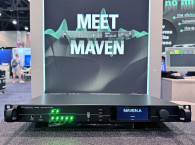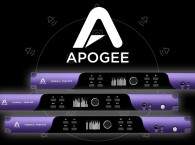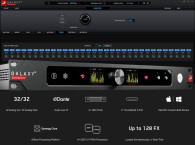
The successor MADIface XT II maintains this formula and surpasses the signal values of its predecessor in numerous areas. Among other things, as RME explains, the new MADIface XT II delivers a higher signal-to-noise ratio and a lower THD value during AD conversion. Also, the maximum balanced line output level of the XLR line outputs has been increased from +15 dBu to +24 dBu. The stereo headphone output of the MADIface XT II also delivers a significantly higher output level of +19 dBu and with an output impedance of 1 Ohm significantly more power than its predecessor. All outputs also have several switchable level options.
On the new digital board the previous analog mini-DIN socket for remote control of individual functions has been replaced by an ARC USB remote port which enables comprehensive control of the MADIface XT II with the optional ARC USB hardware controller. This optional ARC USB unit for RME audio interfaces is bus powered and talks to the TotalMix FX software directly. It has 15 freely assignable and illuminated buttons, one encoder wheel, and a TS jack to connect a foot switch. The MADIface XT II also offers the Room EQ known from the Fireface UFX III with nine parametric bands for use in surround setups for up to 20 mono output channels.
As with other RME interfaces, the new MADIface XT II comes with the TotalMix FX DSP mixer offering comprehensive routing and monitoring options, as well as the DigiCheck Analyzer allowing to measure and analyze the digital data feed in both directions with maximum precision. TotalMix FX can completely replace an external mixer, enabling the creation of multiple latency-free monitor mixes with EQ, Dynamics, Reverb and Delay for any outputs, incl. main monitors and headphone mixes for musicians.
The additional TotalMix Remote is a remote control for TotalMix FX, to control the hardware mixer and effects in RME audio interfaces. TotalMix Remote mirrors the current state of the host system on the iPad and Windows/Mac computers - the entire mixing state, the complete routing, all FX settings, up to the level meters, and everything in real-time. With this useful tool, users can easily adjust all the mixer and FX settings from a distance, via Ethernet and WiFi.
Using RME's latest SteadyClock FS the MADIface XT II features improved clock and jitter rejection technology compared to its older brother. Based on a femto clock, SteadyClock FS reduces the intrinsic jitter of the MADIface XT II to an absolute minimum and filters clock jitter efficiently from as low as 1Hz.

This is a great design update from RME, and makes the MADIface XT II interface an extremely powerful option. We can hardly wait to see what happens when RME finally embraces USB4 and replaces the vintage Type B connector with an updated USB Type-C. Although we hardly doubt that anyone will need even more channels for such a compact unit, for one the interface could then be powered via USB-C (removing the need for the external power supply), add MIDI 2.0 support via USB-C, and no one would need to keep discontinued Type B cables. By the way, as can be seen in the rear panel, this USB 3.0 unit uses a different Type B connector that is not backward compatible with older generation Type B (typical in hifi) and have a different pin out (and that is why they were discontinued and replaced by Type-C in 2014).
The RME MADIface XT II is available with immediate effect.
www.audioag.com | www.synthax.com
www.rme-audio.de







